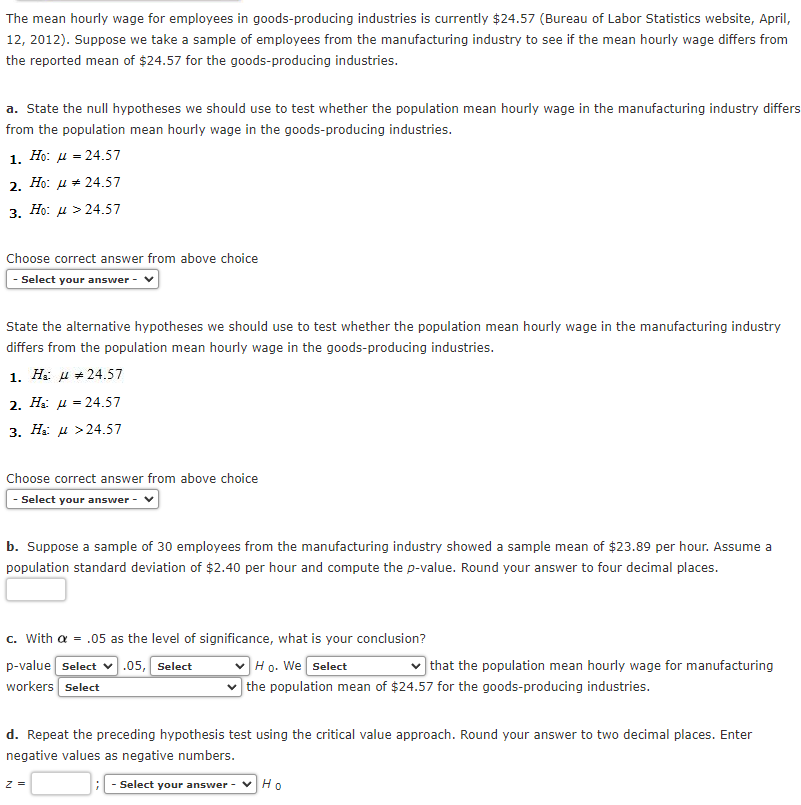The mean hourly wage for employees in goods-producing industries is currently $24.57 (Bureau of Labor Statistics website, April, 12, 2012). Suppose we take a sample of employees from the manufacturing industry to see if the mean hourly wage differs from the reported mean of $24.57 for the goods-producing industries. a. State the null hypotheses we should use to test whether the population mean hourly wage in the manufacturing industry differs from the population mean hourly wage in the goods-producing industries. 1. Ho: μ-24.57 2. Ho: u + 24.57 3. Но: и > 24.57 Choose correct answer from above choice - Select your answer - State the alternative hypotheses we should use to test whether the population mean hourly wage in the manufacturing industry differs from the population mean hourly wage in the goods-producing industries. 1. Hi u + 24.57 2. Hi: u = 24.57 3. На и >24.57 Choose correct answer from above choice - Select your answer - v b. Suppose a sample of 30 employees from the manufacturing industry showed a sample mean of $23.89 per hour. Assume a population standard deviation of $2.40 per hour and compute the p-value. Round your answer to four decimal places. c. With a = .05 as the level of significance, what is your conclusion? Ho. We Select the population mean of $24.57 for the goods-producing industries. | that the population mean hourly wage for manufacturing p-value Select v.05, Select workers Select d. Repeat the preceding hypothesis test using the critical value approach. Round your answer to two decimal places. Enter negative values as negative numbers. z = Select your answer - V Ho
The mean hourly wage for employees in goods-producing industries is currently $24.57 (Bureau of Labor Statistics website, April, 12, 2012). Suppose we take a sample of employees from the manufacturing industry to see if the mean hourly wage differs from the reported mean of $24.57 for the goods-producing industries. a. State the null hypotheses we should use to test whether the population mean hourly wage in the manufacturing industry differs from the population mean hourly wage in the goods-producing industries. 1. Ho: μ-24.57 2. Ho: u + 24.57 3. Но: и > 24.57 Choose correct answer from above choice - Select your answer - State the alternative hypotheses we should use to test whether the population mean hourly wage in the manufacturing industry differs from the population mean hourly wage in the goods-producing industries. 1. Hi u + 24.57 2. Hi: u = 24.57 3. На и >24.57 Choose correct answer from above choice - Select your answer - v b. Suppose a sample of 30 employees from the manufacturing industry showed a sample mean of $23.89 per hour. Assume a population standard deviation of $2.40 per hour and compute the p-value. Round your answer to four decimal places. c. With a = .05 as the level of significance, what is your conclusion? Ho. We Select the population mean of $24.57 for the goods-producing industries. | that the population mean hourly wage for manufacturing p-value Select v.05, Select workers Select d. Repeat the preceding hypothesis test using the critical value approach. Round your answer to two decimal places. Enter negative values as negative numbers. z = Select your answer - V Ho
Glencoe Algebra 1, Student Edition, 9780079039897, 0079039898, 2018
18th Edition
ISBN:9780079039897
Author:Carter
Publisher:Carter
Chapter10: Statistics
Section10.4: Distributions Of Data
Problem 19PFA
Related questions
Question

Transcribed Image Text:The mean hourly wage for employees in goods-producing industries is currently $24.57 (Bureau of Labor Statistics website, April,
12, 2012). Suppose we take a sample of employees from the manufacturing industry to see if the mean hourly wage differs from
the reported mean of $24.57 for the goods-producing industries.
a. State the null hypotheses we should use to test whether the population mean hourly wage in the manufacturing industry differs
from the population mean hourly wage in the goods-producing industries.
1. Ho: μ-24.57
2. Ho: u + 24.57
3. Но: и > 24.57
Choose correct answer from above choice
- Select your answer -
State the alternative hypotheses we should use to test whether the population mean hourly wage in the manufacturing industry
differs from the population mean hourly wage in the goods-producing industries.
1. Hi u + 24.57
2. Hi: u = 24.57
3. На и >24.57
Choose correct answer from above choice
- Select your answer - v
b. Suppose a sample of 30 employees from the manufacturing industry showed a sample mean of $23.89 per hour. Assume a
population standard deviation of $2.40 per hour and compute the p-value. Round your answer to four decimal places.
c. With a = .05 as the level of significance, what is your conclusion?
Ho. We Select
the population mean of $24.57 for the goods-producing industries.
| that the population mean hourly wage for manufacturing
p-value Select v.05, Select
workers Select
d. Repeat the preceding hypothesis test using the critical value approach. Round your answer to two decimal places. Enter
negative values as negative numbers.
Select your answer - V Ho
Expert Solution
This question has been solved!
Explore an expertly crafted, step-by-step solution for a thorough understanding of key concepts.
This is a popular solution!
Trending now
This is a popular solution!
Step by step
Solved in 3 steps with 1 images

Recommended textbooks for you

Glencoe Algebra 1, Student Edition, 9780079039897…
Algebra
ISBN:
9780079039897
Author:
Carter
Publisher:
McGraw Hill

College Algebra (MindTap Course List)
Algebra
ISBN:
9781305652231
Author:
R. David Gustafson, Jeff Hughes
Publisher:
Cengage Learning

Glencoe Algebra 1, Student Edition, 9780079039897…
Algebra
ISBN:
9780079039897
Author:
Carter
Publisher:
McGraw Hill

College Algebra (MindTap Course List)
Algebra
ISBN:
9781305652231
Author:
R. David Gustafson, Jeff Hughes
Publisher:
Cengage Learning